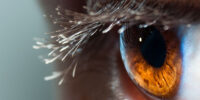Can Genetics Influence Your Risk of Eye Conditions

The influence of genetics on the risk of developing eye conditions has been a subject of scientific investigation. Understanding the role of genetic factors in common eye disorders is essential for effective prevention and management strategies.
Genetic testing can provide valuable insights into an individual’s susceptibility to eye conditions, particularly age-related diseases and refractive errors. Moreover, genetic influences have been implicated in the development and progression of glaucoma and retinal disorders.
This article aims to explore the extent to which genetics can determine an individual’s risk of developing various eye conditions.
Key Takeaways
- Genetic variations play a significant role in the risk of developing hereditary eye conditions.
- Genetic testing can assess an individual’s risk for eye conditions and enable early detection and intervention.
- Genetic counseling is essential in the process of predictive genetic testing to help individuals understand the implications of their test results and make informed decisions about their healthcare management.
- Epigenetic changes and specific gene variations can elevate the risk of developing certain eye conditions, such as glaucoma and retinal disorders, and studying genetic factors aids in identifying potential therapeutic targets and developing personalized treatments.
The Role of Genetic Factors in Eye Conditions
The role of genetic factors in the development and progression of eye conditions has been widely studied and documented in scientific literature. Genetic variations play a significant role in the risk of developing various hereditary eye conditions. These genetic variations can affect the structure and function of the eye, leading to abnormalities and increased susceptibility to certain eye conditions.
For example, certain mutations in genes involved in the development of the eye can result in conditions such as retinitis pigmentosa and congenital cataracts. Additionally, variations in genes related to the regulation of intraocular pressure have been linked to the development of glaucoma.
Understanding the genetic basis of these conditions can provide valuable insights into their pathogenesis and help in the development of targeted therapies and preventive measures.
Understanding the Genetic Basis of Common Eye Disorders
The genetic basis of common eye disorders has been the subject of extensive research in recent years. One key area of investigation has focused on identifying genetic markers associated with blindness.
Understanding the role of genetic markers in inherited eye disease risks can provide valuable insights into the underlying mechanisms and potential avenues for targeted interventions and treatments.
Genetic Markers for Blindness
Genetic markers associated with blindness have been identified through various studies. These markers indicate a genetic predisposition to hereditary vision loss and play a crucial role in understanding the underlying mechanisms of blindness.
One study conducted by researchers at the University of California, Los Angeles, identified a genetic marker called ABCA4, which is associated with age-related macular degeneration (AMD), a leading cause of blindness in older adults.
Another study, published in the journal Nature Genetics, identified a genetic variant in the EYS gene that is linked to retinitis pigmentosa, a progressive retinal disease that can lead to complete blindness.
These findings highlight the importance of genetic markers in predicting and understanding the risk of blindness, paving the way for targeted interventions and personalized treatment strategies in individuals with a genetic predisposition to vision loss.
Inherited Eye Disease Risks
Inherited eye diseases pose significant health risks and can lead to vision loss or blindness. These conditions are caused by genetic abnormalities that are passed down from parents to their offspring. The prevalence of inherited eye diseases varies depending on the specific condition and the population being studied. However, they are generally considered to be rare.
Genetic counseling is an important option for individuals and families affected by inherited eye diseases. It provides information and support regarding the genetic basis of the disease, risk assessment for family members, and reproductive options. Genetic counselors can help individuals make informed decisions about family planning and provide resources for managing the condition. Additionally, they can offer emotional support and connect patients with support groups and other resources.
Genetic Testing: Assessing Your Risk for Eye Conditions
Assessing the risk for eye conditions can be done through genetic testing. Genetic predisposition plays a significant role in determining an individual’s susceptibility to certain eye conditions. By analyzing an individual’s genetic makeup, healthcare professionals can identify specific genetic variants that are associated with an increased risk of developing eye conditions. This information can then be used to provide personalized eye care, tailored to the individual’s specific genetic profile. Genetic testing allows for early detection and intervention, enabling healthcare professionals to implement preventive measures or develop targeted treatment plans. It also allows individuals to make informed decisions about their eye health, such as lifestyle modifications or regular screenings. The following table provides a visual representation of the different eye conditions and their associated genetic markers:
| Eye Condition | Genetic Marker | Risk Level |
|---|---|---|
| Age-related macular degeneration | CFH gene | High |
| Glaucoma | MYOC gene | Moderate |
| Retinitis pigmentosa | RHO gene | Low |
Table: Genetic markers and risk levels for selected eye conditions.
Exploring the Link Between Genes and Age-Related Eye Diseases
A better understanding of the relationship between specific genes and age-related eye diseases can contribute to advancements in preventive measures and targeted treatments. Genetic mutations play a significant role in the development of hereditary eye diseases, and identifying these mutations can aid in early diagnosis and intervention.
Researchers have made notable progress in unraveling the genetic basis of age-related eye diseases, such as macular degeneration and glaucoma. The complex interplay between multiple genes and environmental factors complicates the study of these diseases.
Nonetheless, recent studies have identified several key genes associated with age-related eye diseases, including CFH, ARMS2, and CYP1B1. These genes are involved in processes such as inflammation, oxidative stress, and angiogenesis, which are known to be dysregulated in these conditions.
Understanding the specific genetic mechanisms at play can pave the way for targeted therapies and personalized medicine in the future.
Genetics and the Development of Refractive Errors
This discussion aims to explore the roles of genetic and environmental factors in the development of refractive errors.
Refractive errors, such as myopia, hyperopia, and astigmatism, are common vision disorders that can impact visual acuity.
Understanding the contributions of genetics and environmental factors is crucial for predicting and managing these conditions.
Predictive genetic testing can provide valuable insights into an individual’s risk of developing refractive errors.
Genetic Vs Environmental Factors
The influence of genetic and environmental factors on the development and progression of eye conditions has been extensively studied in scientific research. Understanding the interplay between these factors is crucial in determining an individual’s risk for developing certain eye conditions.
The following factors contribute to this complex relationship:
- Environmental factors: Exposure to certain environmental factors, such as ultraviolet radiation, smoking, and poor nutrition, can increase the risk of developing eye conditions.
- Genetic factors: Certain genetic variations have been identified as risk factors for specific eye conditions, including age-related macular degeneration and glaucoma.
- Lifestyle choices: Unhealthy lifestyle choices, such as a sedentary lifestyle or excessive alcohol consumption, can further exacerbate the genetic predisposition to eye conditions.
- Gene-environment interactions: The interaction between genetic predisposition and environmental factors can significantly influence an individual’s risk of developing eye conditions.
- Epigenetic modifications: Epigenetic changes, such as DNA methylation or histone modifications, can mediate the effects of environmental factors on gene expression, potentially influencing the development and progression of eye conditions.
Overall, the interplay between genetic and environmental factors plays a crucial role in determining an individual’s risk of developing eye conditions. Further research is needed to fully understand the complex mechanisms underlying these interactions.
Predictive Genetic Testing
Predictive genetic testing has emerged as a valuable tool for assessing an individual’s susceptibility to developing certain ocular disorders. This type of testing involves the analysis of an individual’s DNA to identify specific genetic variations that are associated with an increased risk of developing eye conditions.
By identifying these genetic variations, predictive genetic testing can provide valuable information about an individual’s likelihood of developing a particular ocular disorder in the future. This information can be used to guide preventative measures, such as lifestyle modifications or early interventions, to reduce the risk or delay the onset of the condition.
Genetic counseling plays a crucial role in the process of predictive genetic testing, as it helps individuals understand the implications of their test results and make informed decisions about their healthcare management.
Genetic Influences on Glaucoma and Its Progression
Genetic factors play a role in the development and progression of glaucoma, an eye condition characterized by damage to the optic nerve. Understanding the genetic influences on glaucoma is crucial for early detection, prevention, and personalized treatment strategies. Here are some key points to consider:
- Variations in specific genes can increase the risk of developing glaucoma.
- Mutations in the MYOC gene have been associated with a higher likelihood of primary open-angle glaucoma.
- Genetic influences on cataracts are also important to consider, as they can coexist with glaucoma and contribute to visual impairment.
- Hereditary factors in macular degeneration, such as variations in the CFH and ARMS2 genes, may also impact glaucoma risk.
- Studying the genetic factors involved in glaucoma can help identify potential therapeutic targets and develop targeted treatments.
Can Genetics Determine Your Susceptibility to Retinal Disorders?
Research has shown that variations in specific genes can play a significant role in determining an individual’s susceptibility to retinal disorders. Genetic testing accuracy has greatly improved in recent years, allowing for the identification of specific genetic mutations associated with retinal disorders.
By analyzing an individual’s DNA, genetic testing can provide valuable information about their risk of developing these disorders. This information can be used to inform medical management decisions and potentially guide preventive strategies.
Additionally, genetic counseling options are available to individuals who undergo genetic testing for retinal disorders. Genetic counselors can help individuals understand the results of their genetic testing, provide information about the potential implications, and offer support and guidance in making informed decisions about their healthcare. Genetic counseling can also address ethical and psychological considerations associated with genetic testing for retinal disorders.
Overall, advancements in genetic testing accuracy and the availability of genetic counseling options have greatly improved our ability to determine an individual’s genetic susceptibility to retinal disorders.
Frequently Asked Questions
Are Eye Conditions Solely Determined by Genetics or Can Other Factors Play a Role?
The etiology of eye conditions involves both genetic and environmental factors. While genetic factors play a significant role in determining one’s susceptibility, other factors such as lifestyle choices and environmental exposures can also impact the development and progression of eye conditions.
Can Genetic Testing Accurately Predict an Individual’s Risk of Developing Eye Conditions?
Genetic testing has limitations in accurately predicting an individual’s risk of developing eye conditions. Factors beyond genetics, such as environmental influences and lifestyle choices, play a role in the overall risk.
How Do Age-Related Eye Diseases Interact With Genetic Factors?
The interaction between age-related eye diseases and genetic factors has been studied extensively. Research has shown that genetic factors play a significant role in the development of age-related macular degeneration and cataracts.
Are There Certain Genes That Are Known to Be Associated With Refractive Errors?
Genetic susceptibility plays a role in the development of refractive errors, such as myopia. Certain genes have been identified to be associated with the inheritance of myopia, indicating a potential genetic influence on the risk of refractive errors.
Can Genetic Factors Influence the Progression or Severity of Glaucoma?
Genetic factors can influence the progression or severity of glaucoma. Certain genetic mutations have been associated with an increased risk of developing glaucoma, and familial inheritance plays a role in the transmission of this condition.







